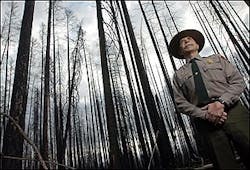Finding Fire Fighting Veterans to Fill Leadership Roles is Getting More Difficult Each Year in Montana
BILLINGS, Mont. (AP) -- Wally Bennett remembers how it once was, going for eight, maybe 10 days on a fire assignment, then coming home with the battle won and much of the summer left.
But in recent years, with the Western fire season becoming longer and the fires more intense, the demand for specialized incident management teams like his has grown, and so have the demands on team members.
''And that gets to be quite a burden on the people,'' said Bennett, 58, who juggles his firefighter duties with a state job in Kalispell. ''It's a major impact on your family.'''
Federal fire officials say it's getting harder to find experienced fire managers like Bennett who are willing to drop everything on a couple hours' notice to serve on the highly skilled teams used to confront the nation's most complex blazes.
Retirements, disinterest and increased responsibilities at home and work are shrinking the number of people able, or willing, to work with top-level incident management teams. And, there are fewer of those teams now than 15 years ago.
''Certainly, standing still isn't an option,'' said Tom Harbour, the director of fire and aviation for the U.S. Forest Service.
An interagency report released earlier this year recommends, among other things, creating smaller, full-time teams focused on incident management, to ease the strain on the existing ones, and requiring federal land agency workers to get involved in fire management efforts.
That was the expectation when Mike Lohrey started out more than 30 years ago. While the expectation is still found in agency manuals, it is not being enforced, the report said.
''We have to get back to saying, 'This is part of our duties,''' said Lohrey, who is with the U.S. Forest Service in Oregon.
The study found a ''skill gap'' of workers ready to assume high-ranking incident management roles. It also cited a 2003 survey of upper tier incident management teams, area command, Type 1 and Type 2 teams, that indicated most members would need to be replaced in the next few years. Some of those gaps are now already being filled by retirees.
Type 1 incident command teams carry about 30 members, including experts on planning, logistics, safety and finance. The teams take turns being on-call for complex wildfires and other emergencies, like hurricane relief, and need to be packed and ready to roll within two hours.
Qualification takes years, sometimes the better part of a career.
When Steve Frye began his firefighting career in 1966, he considered a 2,000-acre fire a big deal. Over the years, the fires have gotten larger and more complex, threatening communities and housing developments.
Frye, who led a Type 1 team for nine years, saw both sides of the fight in the summer of 2003. While he was managing fires, and the armies of personnel fighting them, a blaze at Glacier National Park was threatening his own family's home.
''I had great confidence in the teams here, but I can assure you, it was a very intense time for me,'' said Frye, the park's chief ranger.
Frye stepped down as incident commander after last season, making way for another leader whose tenure Frye says may be cut short by work obligations.
Incident management teams are not full-time jobs, though some years, it can seem that way to members like Phil Perkins. According to the report, the number of assignments for teams grew from an average of 2.5 before 1994 to 5.3 assignments in 2003. Non-fire events such as hurricane relief and the recovery of the shuttle Columbia also have demanded the teams' attention.
Perkins, the fire management officer at Yellowstone National Park, said he missed his children's first day of school, when he was dealing with park fires in 1988. And, in recent summers, his assistant had to pick up some of his park duties.
Harbour, who was part of the group that worked on the incident management report, said there is sufficient manpower to deal with what could be a busy wildfire season out West this summer. But he sees the proposals as offering a ''more holistic approach to success in the future.''
A team of fire officials planned to meet to consider how the study's recommendations can be implemented. A report from the task group was expected this fall.
On the Net:
USDA Forest Service Fire and Aviation Management: www.fs.fed.us/fire
